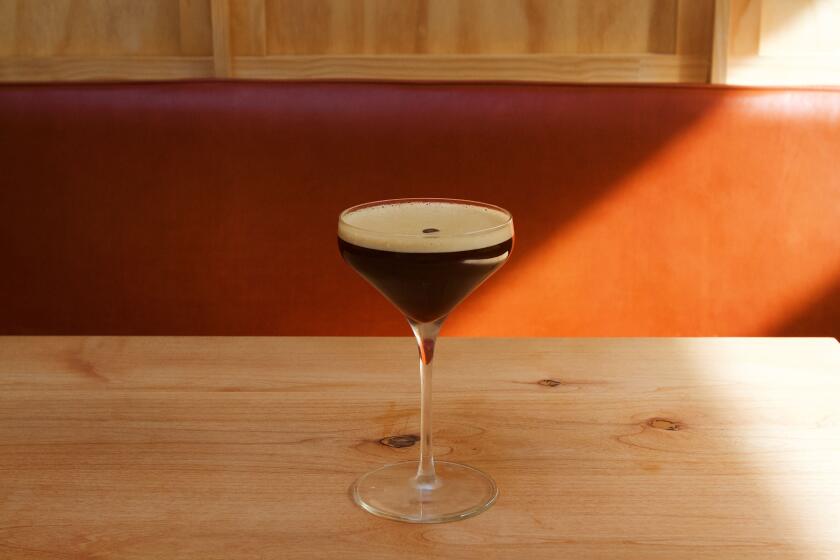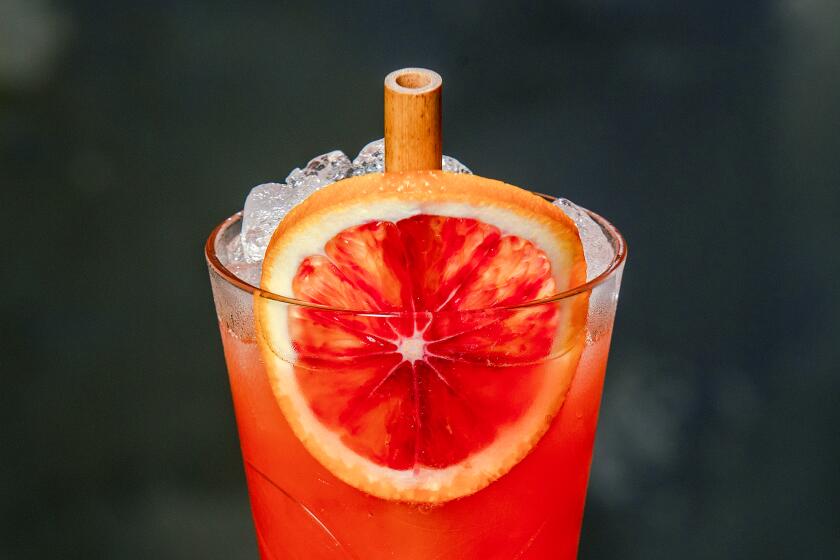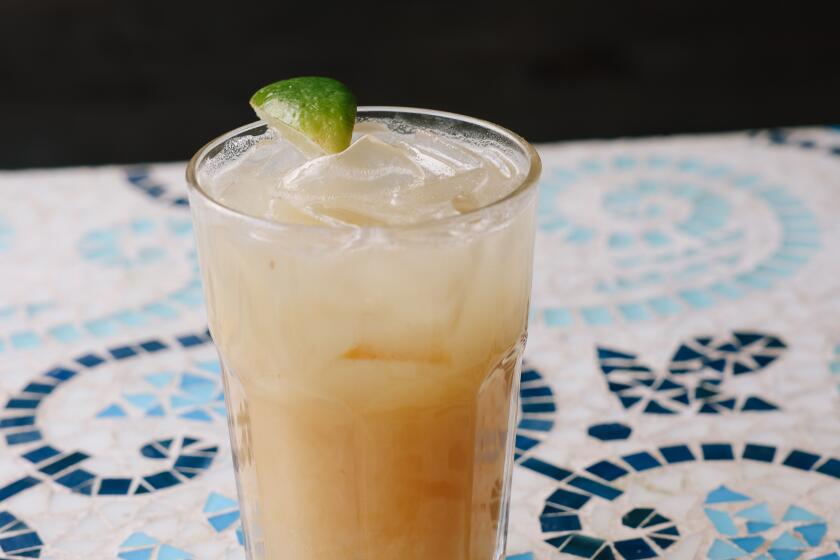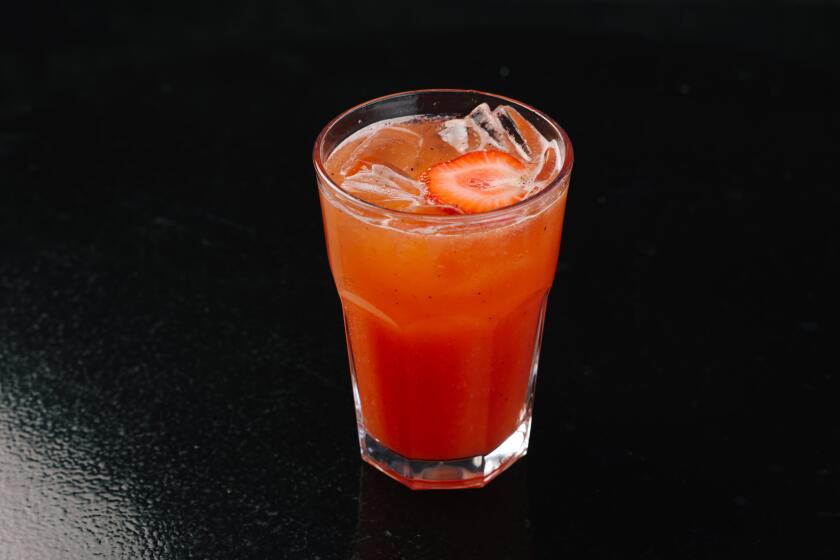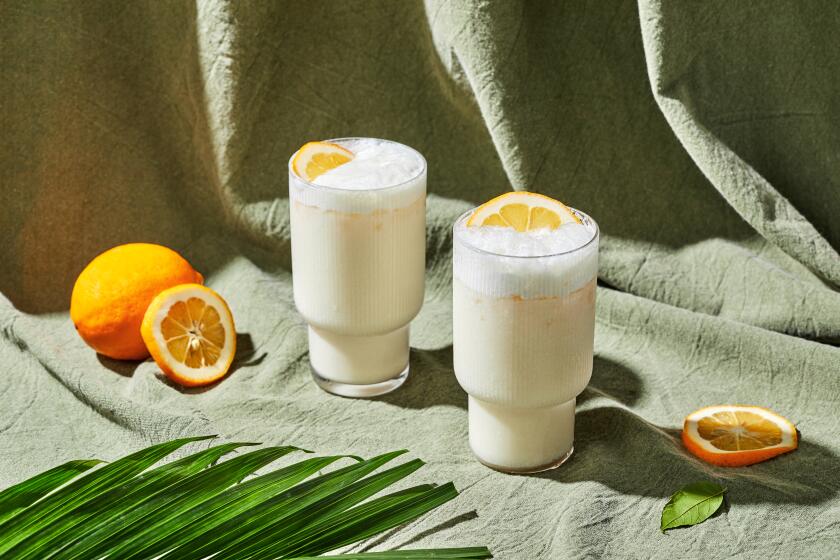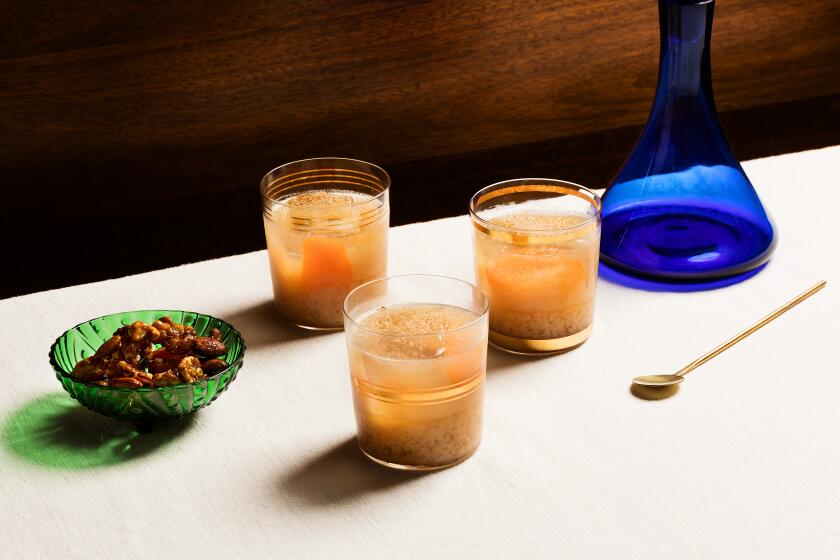Aromatherapy cocktail

I blame James Bond. Everything started going downhill, cocktail-wise, when he insisted on vodka martinis, shaken, not stirred. That sounded ultra-suave in the ‘60s, but the vodka martini has a fatal flaw -- it lacks the heady aromatics and complex palate of gin (which must be why Ian Fleming actually specified a mixture of vodka and gin in “Casino Royale”). A straight vodka martini is a cocktail with a hole in the middle.
People were bound to fill that hole with something, and just look at what they’re doing. The sugary, imitation fruit-flavored vodka cocktails being poured these days make me feel I’m at some kind of naughty children’s Kool-Aid party.
I say a lot of these cocktails are suffering from gin deprivation, and apparently I’m not the only one who feels gin has been unjustly neglected of late. There’s more interest in gin these days than there has been in many years. “It’s something I notice around town,” says dining room manager Jeremy Allen of Norman’s in West Hollywood. “I think people are exploring.”
Here’s the best sign of a gin revival: In recent years, a whole category of boutique gins has arisen alongside the long-established brands.
The bartenders’ favorite seems to be Hendrick’s, a Scottish gin, which is so distinctive and yet refined that it creates remarkable cocktails. But keep your eyes open at leading bars around town and you’re likely to notice other unfamiliar names, such as Junipero, from the Bay Area; France’s Citadelle; a gin made by a Sonoma winemaker, No. 209; and Old Raj, another Scottish entry.
Anchor Brewing had just started making a rye whiskey in 1996 when owner Fritz Maytag decided to make a gin as well -- and discovered how much there was to learn. “I made a list of all the ingredients anybody ever mentioned in gin,” he says, “First we made a minimalist gin with the three basic ingredients everybody uses, then we added one botanical at a time to see what they do.
“We experimented and wandered in a wilderness for a long time. Then one day I just said, ‘Stop, this is great.’ ” Maytag’s Junipero is powerful and sculptured, loaded with gin’s distinctive juniper flavor.
Leslie Rudd fell into gin, as it were, when he bought the Edge Hill Winery in St. Helena, Calif., and discovered that in 1882 it had become U.S. registered distillery No. 209, producing gin and other spirits. Napa County does not permit distilling anything but grape-based spirits such as brandy and grappa, so Rudd set up his No. 209 operation -- which uses a still custom-made for him in Scotland -- in San Francisco. It’s a subtle, well-considered gin that makes a sophisticated cocktail.
Juniper’s the key
GIN was invented for medicinal purposes by a 17th century Dutch physician named Franciscus Sylvius, who added juniper berries, spices and other botanicals to distilled spirits. During the 18th century, the English took to drinking gin for its alcohol content, but in the 19th century, despite gin’s bad rep -- it had become a byword for alcohol abuse -- bartenders noticed that its crisp, piney flavor performed excellently in mixed drinks. In particular, it wedded beautifully with the body and winy aromas of vermouth. The all-time classic gin cocktail is the dry martini, created almost exactly 100 years ago, a cocktail so sleek and powerful it has been nicknamed the Silver Bullet.
As a result of this discovery, gin moved out of the categories of dubious medicine and cheap hooch to became one of the classic cocktail bases, along with whiskey, brandy, champagne and rum. Gin is the only one of that group that is never aged (or hardly ever -- Kensington, one of the boutique gins most appreciated by The Times tasting panel, is aged in oak) and gets its aroma entirely from added ingredients.
It starts as grain spirit (vodka, in effect; many gin distillers are also vodka-makers these days). The botanicals are steeped in it, it’s distilled one more time, and voila: gin.
To be called gin, it has to include juniper berries -- its very name comes from the French or Dutch word for juniper. This provides gin’s unique, refreshing outdoorsy scent. It always contains some citrus peel, either lemon or bitter orange or both. After that, the distiller has a huge range of choices. Coriander and anise are very common, but some gins use 20 or more botanicals such as cucumber, licorice, rose petals or almonds.
One of the most important is angelica, a cold-climate member of the carrot family that flourishes in Northern Europe. Angelica is astringent; it’s the reason gin doesn’t have a cloying aftertaste. Another traditional ingredient is orris root, which has a mild, funky herbal smell somewhat resembling violets. More important, orris root binds volatile aromas, which would otherwise evaporate more rapidly than they do.
For a long time -- call it the Seagram’s age -- many people seemed to think of gin as an industrial product without significant differences among brands. But recently, more than a dozen specialty gins have appeared on the market, showing an extravagant variety of styles: powerful gins for memorable cocktails, delicate or exotic ones for sipping, new takes on classical gins with a twist of their own.
About half of the companies marketing these new-wave gins have long experience in spirits, such as mainline gin distiller Tanqueray and the French firm Cognac Ferrand. There’s a surprisingly strong Scottish presence. Hendrick’s comes from the Girvan Distillery, which supplies grain whisky for the Grant & Sons brand of blended scotches. Old Raj is distilled for Wm. Cadenhead, a specialist in bottling high-end single malts. Ian Macleod Distillers, producers of Scotch and many other spirits, makes the remarkable Kensington, which tastes like a cross between gin and aged whisky.
Among the West Coast gins, the best are the two made by companies moving up from less alcoholic beverages, Junipero No. 209. Other brands are mostly the work of newcomers to the business, based in places as various as Chicago, Santa Cruz, Princeton, Minn., and Bend, Ore. Martin Miller’s sends its freshly distilled gin from London to Iceland to be brought down to 80 proof with the local water.
Most of the new gins show the ongoing effects of Sapphire’s explosive effect on the design of gin bottles. Instead of being packaged in old-fashioned squared-off bottles, most of them arrive in fanciful containers that look like giant perfume jars.
Pot-distilled products
BUT the real differences are inside the bottle. The well-known gin brands, like most spirits in the modern world, are distilled in high-volume column stills. In contrast, eight of the newcomers boast that they use the old-fashioned pot still, the kind associated with Cognac and Scotch malt whisky.
Pot stills are slower and less efficient than column stills but can make a more distinctive product, and most of the pot-distilled gins we tasted were particularly good.
There’s no single style to these new gins. Several of the newcomers have a somewhat unfocused flavor, but the Bay Area brewery and winery distill splendid, rather classical gins. Scotland produced three of our favorites, all quite distinctive, and they could scarcely be more different: Hendrick’s poetic and delicate, Old Raj rich and robust, Kensington startlingly original.
These new gins are so good they can be sipped straight, but they also make spectacular cocktails. Chiseled, aggressively juniper-flavored Junipero makes a bold, broad-shouldered dry martini, while Hendrick’s produces virtually the opposite: elegant, layered, almost floral.
With its whisky-like notes, a Kensington Martini is halfway to a Rob Roy, and Old Raj is such a flavorful gin that you need to add more vermouth than you otherwise would (yes, ultra-dry martini fans, this is one case when gin can overpower vermouth).
In the gin market, these brands are just the proverbial drop in the bucket. But they reveal new possibilities.
Maybe, one day, some movie character will start a trend by demanding a Harvey Ginbanger, or a Hendrick’s Fuzzy Navel -- easy on the peach schnapps, shaken and stirred.
Pour the gin and elderflower syrup into a tall 12-ounce glass filled with ice. Add the tonic water and soda water, stir and garnish with the flower.
Get our Cooking newsletter.
Your roundup of inspiring recipes and kitchen tricks.
You may occasionally receive promotional content from the Los Angeles Times.










